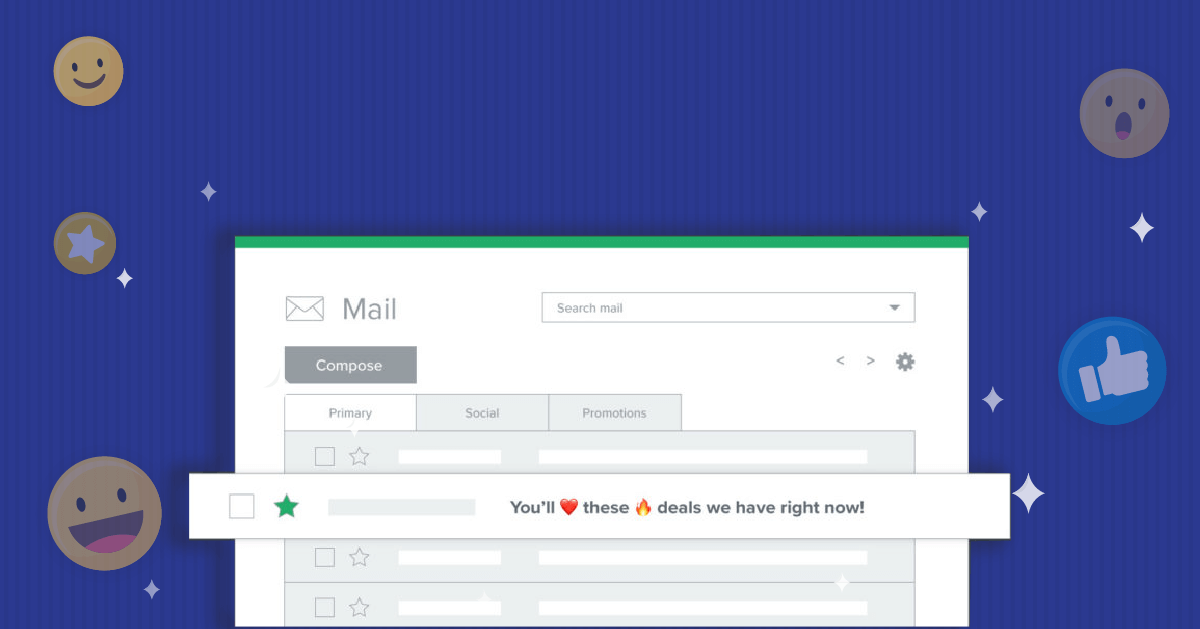From 😀 face to 😂 faces, emojis have made us fall in love with them and changed how we express our emotions digitally. Although we see emojis regularly everywhere, from texts and social media posts to WhatsApp forwards, these cute little icons can often come in handy for email marketers.
Believe it or not, there are only a few things in email marketing that are as boring and yet incredibly important as subject lines. A subject line is a plain sentence that summarises the entire email and entices people to open your email and read through it entirely.
Therefore, it hardly comes off as a surprise that we see a rapid boom in many e-commerce platforms adding emojis to their subject lines. A comprehensive Return Path study on the effect of emojis on email subject lines reveals that emails whose subject lines included emojis had a higher open rate.
If you own an e-commerce platform and are planning to send customized emails to your existing or potential customers, you might also want to try emojis in your subject lines. So, here we are with some of the best practices for using emojis in email subject lines.

Best Practices for Adding Emojis in Subject Lines
1. Little Is More
Just like we are often advised against writing our subject lines in all caps and including excessive punctuation, we should avoid using too many emojis in a subject line. Including too many emojis in your subject line will make your email look spammy. Moreover, there’s no reasonable logic behind using multiple smiley faces in your subject line when one can do the trick for you.
Avoid pushing your luck beyond two emojis. If you were to take my advice, I’d keep it to one to play it safe.
2. Relevance Is The Key
There are thousands of emojis out there that you can use in your email subject lines. So, there’s no particular reason why you should continue using the same emoji now and then. Adding irrelevant emojis that your audience can’t relate to will always adversely impact your engagement rate.
3. Understand Your Audience
What impact emojis have on your email marketing campaign depends on your audience to a great extent. If you use emojis in your email subject lines, you already know who your audience is and how they will react to emojis. But in any case, always consider the following differences.
Old vs. Young
Younger audiences react pretty differently to emojis than their older counterparts. A study that involved 1,000 Americans found that compared to 68% of millennials who favor emojis, only 37% of people over the age of 65 thought so.
While that doesn’t mean that emojis aren’t meant for an older audience, you need to be more considerate while using an emoji if your audience is on the higher end of the age spectrum.
B2B vs. B2C
Emojis significantly alter your email’s tone. While different emojis will have a different impact on your email style, they are all certain to make your email subject line more casual and playful. This can work wonders for B2C emails, given that your brand is fond of informality.
Contrary to B2C emails, the tone in B2B emails has to be much more professional as you deal with other businesses, requiring formal communication. This adds an element of risk in emojis, and they may not look appropriate at times.
Men vs. Women
Research says that women view emojis much more favorably than men. Although the difference between men and women who viewed emojis positively was substantial, both are likely to respond favorably to emojis.
4. Unlimited Testing
Regardless of whether or not you understand your customers, you will have no idea about their anticipated response until you begin including emojis in your email subject lines. Therefore, your best option is the A/B testing of your subject lines by using one subject line with an emoji and the other one without. Repeating this a few times would give you a clear idea about the effect of an emoji on the CTRs of your email.
Things to Keep in Mind While Adding Emojis in Email Subject Lines
There are a couple of things that you must consider while including an emoji in your email subject line.
1. Emojis Look Different on Different Devices
An emoji may or may not look the same on different devices. This is because every operating system has a foreign design language. For example, the smiley face is rendered differently across other platforms.
2. New Emojis May Not Render Initially
Every year, we see a new set of emojis being released. Upon the release of new emojis, operating system providers must carry out essential software updates to support these newly released emojis.
You might not even be able to view these emojis because your device has yet to receive an update to render them. Therefore, avoid using any newly released emojis in your subject line to ensure that your subscribers don’t have to see square boxes in places of emojis that have been freshly released recently.
Bottom Line
Subject lines are a great way of letting people know what the email will talk about. Including emojis in your subject lines wisely can offer a lot of information about email automation while attracting people’s attention. However, misusing emojis or with the sole purpose of getting your emails opened by your customers may have an adverse impact and hurt your email marketing campaign.
Hence, first, learn the efficacy of both kinds of subject lines, i.e., those with the emoji and those without the emoji. You can take a final call on whether you should include emojis in your subject lines or not based on how these two types of subject lines perform.
If you’re still confused about how emojis can help you improve the engagement rates for your emails, take Wigzo’s free trial today to see how.













